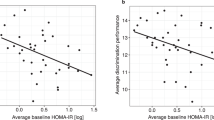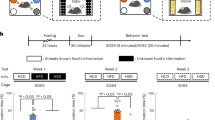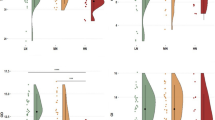Abstract
Objective:
Smell plays an important role in feeding behavior. We therefore tested whether insulin as a postprandial signal is involved in the regulation of olfactory function.
Research design and methods:
We assessed olfactory thresholds in eight lean subjects (age: 34±7 years, M/F: 5/3) before and during a 2-h hyperinsulinemic (1 mU kg−1 min−1) euglycemic clamp and in eight lean fasted subjects (age: 36±6 years, M/F: 5/3) without insulin infusion at the same time of the day. To define odor thresholds, standardized ‘sniffing sticks’ were used.
Results:
Odor thresholds decreased from 7.8±1.2 to 6.2±1.1 during euglycemic hyperinsulinemia (P=0.0173), representing an increase in odor threshold. In the control group, odor thresholds were 8.3±1.6 and did not change after 120 min of fasting (8.9±2.2, P=0.6).
Conclusions:
Increased insulin levels lead to a reduced smelling capacity, potentially reducing the pleasantness of eating. Therefore, insulin action in the olfactory bulb may be involved in the process of satiation and may thus be of interest in the pathogenesis of obesity.
This is a preview of subscription content, access via your institution
Access options
Subscribe to this journal
Receive 12 print issues and online access
$259.00 per year
only $21.58 per issue
Buy this article
- Purchase on Springer Link
- Instant access to full article PDF
Prices may be subject to local taxes which are calculated during checkout

Similar content being viewed by others
References
Aschenbrenner K, Hummel C, Teszmer K, Krone F, Ishimaru T, Seo HS et al. The influence of olfactory loss on dietary behaviors. Laryngoscope 2008; 118: 135–144.
Aime P, Duchamp-Viret P, Chaput MA, Savigner A, Mahfouz M, Julliard AK . Fasting increases and satiation decreases olfactory detection for a neutral odor in rats. Behav Brain Res 2007; 179: 258–264.
Albrecht J, Schreder T, Kleemann AM, Schopf V, Kopietz R, Anzinger A et al. Olfactory detection thresholds and pleasantness of a food-related and a non-food odour in hunger and satiety. Rhinology 2009; 47: 160–165.
Furchtgott E, Friedman MP . The effects of hunger on taste and odor RLs. J Comp Physiol Psychol 1960; 53: 576–581.
Koelega HS . Diurnal variations in olfactory sensitivity and the relationship to food intake. Percept Mot Skills 1994; 78: 215–226.
Baly C, Aioun J, Badonnel K, Lacroix MC, Durieux D, Schlegel C et al. Leptin and its receptors are present in the rat olfactory mucosa and modulated by the nutritional status. Brain Res 2007; 1129: 130–141.
Hass N, Haub H, Stevens R, Breer H, Schwarzenbacher K . Expression of adiponectin receptor 1 in olfactory mucosa of mice. Cell Tissue Res 2008; 334: 187–197.
Guthoff M, Tschritter O, Berg D, Liepelt I, Schulte C, Machicao F et al. Effect of genetic variation in Kv1.3 on olfactory function. Diabetes Metab Res Rev 2009; 25: 523–527.
Hummel T, Sekinger B, Wolf SR, Pauli E, Kobal G . Sniffin’ sticks’: olfactory performance assessed by the combined testing of odor identification, odor discrimination and olfactory threshold. Chem Senses 1997; 22: 39–52.
Stefan N, Machicao F, Staiger H, Machann J, Schick F, Tschritter O et al. Polymorphisms in the gene encoding adiponectin receptor 1 are associated with insulin resistance and high liver fat. Diabetologia 2005; 48: 2282–2291.
Le Floch JP, Le Lievre G, Labroue M, Paul M, Peynegre R, Perlemuter L . Smell dysfunction and related factors in diabetic patients. Diabetes Care 1993; 16: 934–937.
Julliard AK, Chaput MA, Apelbaum A, Aime P, Mahfouz M, Duchamp-Viret P . Changes in rat olfactory detection performance induced by orexin and leptin mimicking fasting and satiation. Behav Brain Res 2007; 183: 123–129.
Savigner A, Duchamp-Viret P, Grosmaitre X, Chaput M, Garcia S, Ma M et al. Modulation of spontaneous and odorant-evoked activity of rat olfactory sensory neurons by two anorectic peptides, insulin and leptin. J Neurophysiol 2009; 101: 2898–2906.
Marks DR, Tucker K, Cavallin MA, Mast TG, Fadool DA . Awake intranasal insulin delivery modifies protein complexes and alters memory, anxiety, and olfactory behaviors. J Neurosci 2009; 29: 6734–6751.
Hallschmid M, Benedict C, Born J, Fehm HL, Kern W . Manipulating central nervous mechanisms of food intake and body weight regulation by intranasal administration of neuropeptides in man. Physiol Behav 2004; 83: 55–64.
Richardson BE, Vander Woude EA, Sudan R, Thompson JS, Leopold DA . Altered olfactory acuity in the morbidly obese. Obes Surg 2004; 14: 967–969.
Roessner V, Bleich S, Banaschewski T, Rothenberger A . Olfactory deficits in anorexia nervosa. Eur Arch Psychiatry Clin Neurosci 2005; 255: 6–9.
Acknowledgements
This study was supported by a grant of the Competence Network for Adipositas funded by the Federal Ministry of Education and Research (FKZ: 01GI0849) and a grant of the Zentrum Ernährungsmedizin Tübingen-Hohenheim (ZEM, grant number 2 A I).
Author information
Authors and Affiliations
Corresponding author
Ethics declarations
Competing interests
The authors declare no conflict of interest.
Rights and permissions
About this article
Cite this article
Ketterer, C., Heni, M., Thamer, C. et al. Acute, short-term hyperinsulinemia increases olfactory threshold in healthy subjects. Int J Obes 35, 1135–1138 (2011). https://doi.org/10.1038/ijo.2010.251
Received:
Revised:
Accepted:
Published:
Issue Date:
DOI: https://doi.org/10.1038/ijo.2010.251
Keywords
This article is cited by
-
Smell, taste and food habits changes along body mass index increase: an observational study
European Archives of Oto-Rhino-Laryngology (2023)
-
The role of insulin sensitivity and intranasally applied insulin on olfactory perception
Scientific Reports (2019)
-
Gehirn und Glukosestoffwechsel
Der Diabetologe (2018)
-
Laparoscopic Sleeve Gastrectomy Improves Olfaction Sensitivity in Morbidly Obese Patients
Obesity Surgery (2016)
-
Impaired insulin action in the human brain: causes and metabolic consequences
Nature Reviews Endocrinology (2015)



